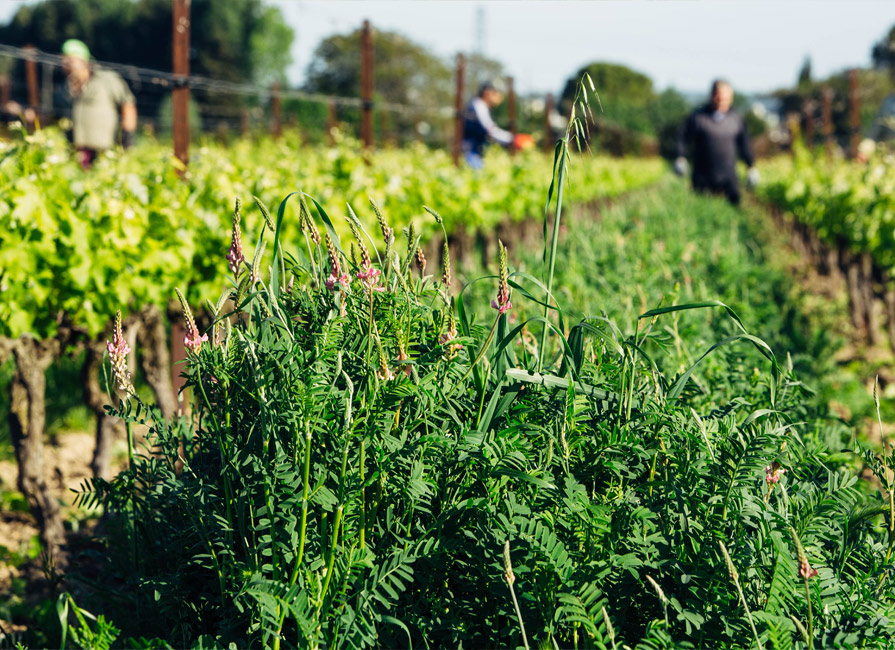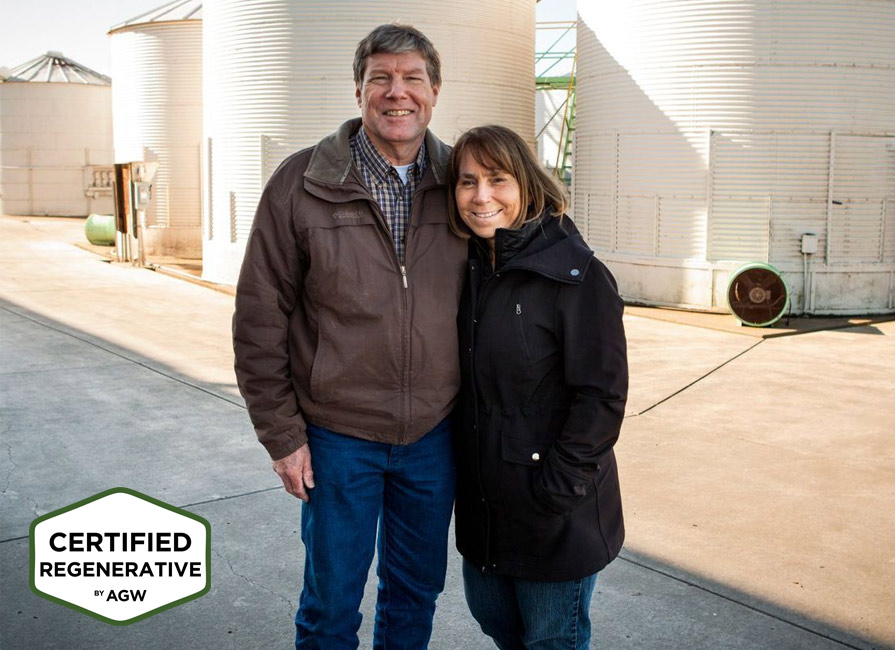Ever since “regenerative agriculture” emerged as a concept, a debate has raged over exactly what…

A New Vintage
According to the Regenerative Viticulture Foundation, less than 20% of vineyards around the world have signed up to some kind of sustainability scheme. Of these, just 6% are certified organic, while less than 1% are certified biodynamic. In this context, the state of regenerative viticulture is still embryonic by comparison. Yet, just like regenerative agriculture, the level of interest in regenerative wine production around the world is growing exponentially.
What Is regenerative?
Although humans have cultivated grapevines for thousands of years, it is only in the last few decades that the devastating impact on vineyard soils and biodiversity from the application of intensive production methods and the widespread use of agrochemicals has become so apparent.
Regenerative viticulture is arguably a return to tradition, but in a modern context. At its heart, it is about regenerating or restoring the soil and local environment. The underlying principles focus on working with the environment and its natural fauna (rather than against them) to rebuild soil health, enhance biodiversity, sequester atmospheric carbon, and improve water cycles, as well as consider the human element of those that live and work the land. Key practices include minimal soil disturbance, cover cropping, composting, integrated livestock grazing, agroforestry, and holistic land management.
The overarching goal is to create resilient viticulture systems that can adapt to changing environmental conditions and reduce reliance on inputs while delivering long-term sustainability and productivity and enhancing the lives of those working in the industry. In practice, this includes:
- Introducing nitrogen-fixing plants as cover crops and/or companion plants
- Integrating livestock, like chickens or sheep, to produce the manure that is essential to feeding the soil naturally
- Adopting no- or low-tilling practices to minimize disruption of the soil ecosystem and enhance the water-holding capacity of the soil
- Reducing reliance on chemical inputs like synthetic fertilizers, insecticides and herbicides
- Increasing business resilience to climate change.
Terroir
In a recent article on regenerative viticulture in Sommeliers Choice, Charlie Leary argues that “soils should be looked after like the treasure for future quality products that they are.” Perhaps the reason why the regenerative approach resonates strongly in the modern viticulture world is that is aligns so closely with the deep-held French concept of ‘terroir’: the idea that a great wine gains much of its character from the particular ecosystem where the grapes were grown. For, as Mimi Casteel of Bethel Heights Vineyard in Oregon says, “the real ceiling on terroir is the biology, the life that built the place that you’re from.”
A toolkit
Speaking at the launch of the Regenerative Viticulture Foundation in 2023, Master of Wine Justin Howard-Sneyd described regenerative agriculture as “a toolkit rather than a prescriptive set of rules.” While the approach of a vineyard owner in England will be significantly different to that of a grower in California, he argues, both can adopt regenerative practices that will help to improve soil health and biodiversity where they are.
This sentiment is closely echoed by Dr Jamie Goode in his new book, Regenerative Viticulture: “There is no recipe. Rather, it’s about taking the regenerative toolkit and applying it in intelligent ways, taking into account the characteristics of the place.”
While regenerative has become a buzzword in the wine world, there is still some confusion about how it differs from organic (or wider sustainable claims). In a nutshell, organic and sustainable approaches tend to focus on excluding or restricting key inputs, such as synthetic fertilizers and pesticides. But as Jancis Robinson points out, organic or sustainable farming practices “have the potential to be damaging to soils, such as regular tractor use, especially on wet soils, causing compaction, and the use of copper, which causes toxic contamination of the soil.” While people often assume organic principles are ‘regenerative,’ organic standards do not actually require the benchmarking of things like soil health, water or air quality, or wildlife species and habitats, social fairness, nor measurement over time to ascertain improvements (or otherwise). This is not a criticism of the organic movement, which has led the way in promoting sustainable food and farming; it’s simply that these key aspects are not benchmarked or monitored under organic certification.
The regenerative approach arguably builds on this foundation and is broadly focused on regeneration and measured improvements of ecosystems through measuring and monitoring metrics like soil health, water and air quality, wildlife species and habitats, and so on. Of course, a vineyard can apply both organic and regenerative approaches simultaneously (see facing page).
But while the strict regime of organic certification may present an insurmountable barrier to many vineyards, it is fair to say that the vast majority could (and should) adopt regenerative practices, and thus begin their regenerative journey.
Certification matters
From a sommelier or wine director’s perspective, it is clear that regenerative viticulture is attracting significant attention in the wine world. Given the high level of interest—and the increasing numbers who claim to practice and deliver its outcomes—the role of independent certification has never been more important. Indeed, the risk of greenwashing (and the ‘Wild West’ of the carbon offsetting market) highlights the need for robust verification of any claims being made.
Certified Regenerative by AGW offers a unique, plan-based approach with standards that encapsulate the main pillars of the practice, namely the stewardship of soil, water, air, and biodiversity, and the care and context of humans in this space in an ethical and community sense.
Accredited to ISO 17065, we offer an objective and credible verification and seeks to ‘meet producers where they are.’ Our unique ethos is one of partnership, rather than direct prescription. We will work with you to develop your own comprehensive management plan, which identifies realistic and meaningful goals for improvement across the main regenerative pillars that can be measure and monitored over time. We fully recognize that a vineyard in the U.S. will have very different growing dynamics and challenges compared to one located in the south of France. Our innovative approach takes into account the unique nature of different systems, soil types, climate, aspect and management of operations. An annual on-site inspection ensures the producer is on track for the journey as originally agreed.
We’re already working with some of the top viticulturists in the world. If you are looking for a trusted, respected, global regenerative certification, we are ready to work alongside you to help you achieve your goals.
Famille Gassier is one of the most renowned estates in France’s Southern Rhone appellation of the Costières de Nîmes. The Gassier family has been producing wine at the estate for five generations and Michel and his daughter, Isabel, have recently embraced regenerative practices:
“Merely transitioning to organic practices in 2007 proved insufficient. Though we ardently uphold organic principles, the European certification process is too prescriptive. Some of its regulations hinder our efforts to enhance the resilience of our vineyards and ecosystems.
“Isabel’s enthusiasm for regenerative viticulture blossomed during her tenure at Enterprise, a California vineyard management company committed to this approach.
“As I learned more, the shift to regenerative agriculture seemed like a natural progression for us. Drawing inspiration from both local and international winemakers and farmers, we embraced regenerative methods when Isabel returned home while maintaining our organic principles.
“To achieve our goals, we chose A Greener World, a certification program developed by and for farmers, known for its personalized technical support. Certified Regenerative by AGW provides a clear framework for identifying, measuring, and monitoring our own targets, with a unique regenerative plan and annual auditing to independently verify progress. It demands transparency from vine to bottle, ensuring our entire operation adheres to measurable and quantifiable objectives.
“Balancing ecology with economics is central to our business approach and regenerative agriculture helps us achieve our environmental and economic goals by focusing on vineyard autonomy, ecosystem biodiversity, quality of workplace life, and profitability.
“One of our key concerns is the impact of climate change—both locally and globally. We are adopting practices to improve soil structure and water retention, which also aids carbon sequestration, water quality enhancement and biodiversity. Focusing on soil regeneration also bolsters the vitality of our vines, enhancing grape quality and allowing our wines to exemplify their true expression of terroir.”
Goals and commitments established in the Gassier regenerative plan include:
- Boosting soil organic matter by 50% by adopting a number of practices, including applying 600 tons of their own compost and going no-till on at least 40% of their vineyards, a real challenge in the Mediterranean climate.
- Diversifying crops and reforesting certain areas of the estate, experimenting with mixed fruit farming and planting tree lines on the north side of their crops.
- Creating natural habitats by planting over 500 meters (1,640 feet) of native hedges annually, allocating at least 20% of the land to pastures and meadows, and restoring the natural course of the stream that runs through our property.
- Introducing animals into the system by extending grazing agreements with local shepherds and encouraging pest predators, such as bats and birds, by installing nest boxes.
- Paying staff fairly and providing quality accommodations and appropriate shelter and facilities, especially during hot weather.
Find out more about the estates of Famille Gassier at chateaudenages.com and domainegassier.com.
FURTHER INFORMATION
The Regenerative Viticulture Foundation is a global nonprofit body made up of wine producers, scientists, educators, agriculture advisors, and environmental organizations working to help reverse climate change. Find out more at regenerativeviticulture.org.
Regenerative Viticulture by Dr. Jamie Goode is the first book specifically to address regenerative viticulture, written from a scientific perspective but in a very accessible, readable way. Self-published via Amazon
With thanks to Plumpton College, East Sussex, UK. Wayne Copp is AGW’s Executive Director Europe
Originally published in the Spring 2024 issue of AGW’s Sustainable Farming magazine.



